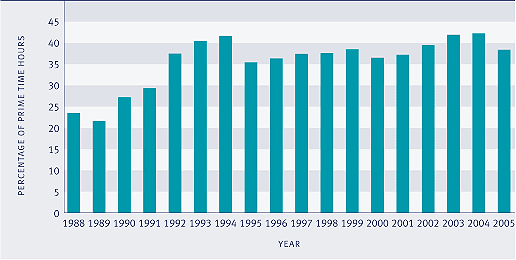Local content programming on New Zealand television
Definition
The number of hours of local content screened on New Zealand television channels during prime-time (6pm to 10pm), as a proportion of the total prime-time schedule.
Local content is generally defined as material both predominantly made in New Zealand and reflective of New Zealand's identity and culture. In 2005, for the first time, the indicator includes information from Māori Television and Prime Television, in addition to the core channels of TV One, TV2 and TV3.
Relevance
Television is the dominant cultural medium for most New Zealanders. The 1998/1999 Time Use Survey showed New Zealanders spend almost two hours per day watching television or videos.72 Ninety-eight percent of New Zealand households have at least one television set.73 For many people, television is a major source of news, information and entertainment. It strongly influences their sense of local and national identity. A local content measure reflects the extent we see our culture reflected through this medium.
Current level and trends
In 2005, the local content on five national free-to-air television channels made up 38 percent of the prime-time schedule. In 2004, when the three main television channels only were included, local content made up 42 percent of the prime-time schedule. The drop in local content coverage between 2004 and 2005 is mainly attributable to the inclusion of Prime Television which has low levels of local content. The proportion of local content in the three main free-to-air channels rose from 24 percent in 1988 to a peak of 42 percent in 1994, before dropping to 35 percent in 1995. It reached 42 percent again in 2003 and 2004.
The percentage of local content in prime-time transmission hours in 2005 differs across the channels: TV One: 61 percent, TV2: 26 percent, TV3: 46 percent, Prime: 9 percent and Māori: 50 percent.
Figure Cl1.1 Proportion of local content on prime-time television, 1988–2005

Source: NZ On Air
Notes: (1) Up to 2004, the figures are for prime-time (6pm–10pm) local content on TV One, TV2 and TV3 only (2) 2005 figures include Prime Television and Māori Television
Three programme types accounted for over half of the local content hours in 2005: news and current affairs (31 percent), information programmes (15 percent) and entertainment (13 percent). Because two new channels have been added, it is not possible to compare information from 2005 with 2004.
Table CI1.1 Percentage share of total hours of local content by programme type, selected years, 1988–2005
| Programme type |
1988 |
1990 |
1995 |
2000 |
2001 |
2002 |
2003 |
2004 |
2005 |
| News, current affairs |
26 |
23 |
21 |
30 |
33 |
29 |
32 |
34 |
31 |
| Information |
10 |
5 |
8 |
17 |
21 |
18 |
19 |
17 |
15 |
| Sports |
24 |
39 |
31 |
20 |
13 |
18 |
14 |
14 |
11 |
| Entertainment |
14 |
12 |
9 |
7 |
9 |
10 |
8 |
9 |
13 |
| Children’s |
15 |
13 |
15 |
10 |
8 |
8 |
10 |
8 |
8 |
| Drama/comedy |
2 |
1 |
7 |
6 |
6 |
6 |
6 |
6 |
5 |
| Māori |
6 |
3 |
3 |
6 |
6 |
5 |
6 |
6 |
9 |
| Documentaries |
2 |
3 |
5 |
4 |
4 |
5 |
5 |
6 |
7 |
| Total New Zealand content hours |
2,112 |
4,249 |
5,018 |
6,185 |
6,190 |
7,201 |
6,526 |
6,423 |
9,306 |
Source: NZ On Air
Notes: (1) Information on types of local programmes in prime-time hours was not published before 2005 (2) These figures relate to a 24-hour period up to 2002. From 2003 onwards, figures relate to 18 hours (6am to midnight)
International comparison
International comparisons are difficult due to inconsistencies in measurement approaches by different countries. However, in 1999, local content accounted for 24 percent of total transmission time in New Zealand, a smaller proportion than in 10 other surveyed countries. This was compared to the United States (90 percent), the United Kingdom (BBC only, 78 percent), Canada (60 percent), Norway (56 percent), Finland (55 percent), Australia (which mandates a local content transmission quota of 55 percent on all free-to-air commercial networks) and Ireland (RTE only, 41 percent).74 This was a measure of total air-time programming rather than prime-time programming, which is the measure this indicator is based on.
|

